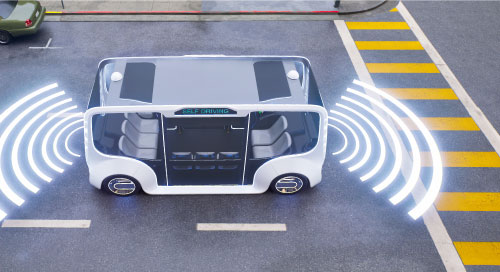Fill form to unlock content
Error - something went wrong!
Your content is just a step away. Please submit below.
Thank you!
Fast-Track Real-Time Kinematics Solution Development

Using GPS as a navigation aid while driving is useful and frustrating in equal measure. While having live directions is a good thing, there are frequent periods when you have to wait for the satellite navigation to catch up with where you actually are on the road.
Such discrepancies in location mapping are mildly annoying at worst, but they are unforgivable when it comes to applications that need more precise positioning information—like autonomous driving. And it’s why real-time kinematics (RTK) is gaining in popularity in applications that need precise positioning.
RTK involves sending “correction data” to a moving receiver, thereby increasing the positioning accuracy that conventional global navigation satellite systems (GNSS) provide. While traditional GNSS receivers receive position data about once every second, RTK is 200 times more frequent. The net result is positioning that is accurate to within one or two centimeters even in fast-moving vehicles.
RAB4 decreases the barriers to the #technology, speeds up the pre-engineering phase and time to market. Rutronik Elektronische Bauelemente GmbH via @insightdottech
RTK “Sandbox” Provides Isolated Testing
And while RTK has been on the market for some time now, only lately has it become economical for wider access, says Stephan Menze, Head of Global Innovation Management at Rutronik Elektronische Bauelemente GmbH, an electronics components and technology solutions provider.
Taking a technology for a test drive sometimes involves going through a lot of detours. Companies often find that they need specific infrastructure and a whole range of different hardware components simply to find out if the solution is even worth pursuing. An isolated testing environment eliminates these roadblocks and delivers faster answers. And it’s why Rutronik developed the Rutronik Adapter Board RAB4, specially designed as a sandbox for RTK development projects. RAB4 decreases barriers to the technology and speeds up the pre-engineering phase and time to market.
RAB4 is a product of Rutronik System Solutions, which launched in 2021 with the goal of creating tools to drive sales and for customers to test specific markets. In the case of RTK, for example, these additional markets might operate drones or lawn mowers or even autonomous driving, all of which can benefit from precision positioning.
RAB4 Adapter Board Components
RTK needs GPS data and a base station that sends corrections. Wi-Fi or Bluetooth connections can work for local base stations. But larger-scale and more-extensive projects such as implementations in smart cities or agriculture likely will need LTE wireless.
The RAB4 Adapter Board has all the necessary elements to test RTK technology: a high-precision RTK positioning module from Unicore; a 4G LTE module for connectivity; necessary antennas; and a SIM card preloaded with 100MB of data for companies to download results and compare data received from the GNSS receiver against those from the RTK receiver. (Video 1)
If a Bluetooth connection is preferred, RAB4 can use an Arduino interface that combines with the Base Board RDK3 that allows such a connection. RAB4 can also link with the Text to Speech Adapter Board, which relays voice outputs on battery status, connection problems, and other information in up to 12 languages. Rutronik also includes software to deliver complete proof-of-concept packages. “We try to show the customer how a system can work, and the customer in the end is thankful for easy access to hardware and software,” Menze says.
Demonstrating Real-Time Kinematics Through a Rover App
To make access to RTK even easier, Rutronik developed a “Rover” and a related app, which the company showcased in the Rutronik booth at embedded world 2024, where visitors could control it themselves. The rover is easy to operate via an app and can be controlled with centimeter precision.
Using an Arduino interface, RAB4 is combined with RDK3, a base board from Rutronik System Solutions, which allows a wireless connection via low-energy Bluetooth. The reference station sends the measured GNSS position to the rover in a real-time protocol via Bluetooth. As a result, the rover knows the distance to the reference station and can navigate with centimeter precision using its relative position to the base station—eliminating the need to lay a wire in the ground as a boundary.
Future iterations of RAB4 are being planned, including models that will use the Intel RealSense camera for collision detection on the rover and other applications. As applications scale into the real world, RTK technology will need high processing power, for which Rutronik will also use Intel, Menze says. The sandbox system currently uses the Infineon microcontroller but plans to use higher-performance Intel processors in future iterations of the RTK and other proof-of-concept solutions. A new base board with an Intel processor is in the development phase.
As for RTK itself, expect more implementations of the technology in the future as smart cities become more common. In such cities, traffic lights can receive data and regulate traffic but to do so safely will need the kind of precision positioning that RTK delivers. Autonomous driving is an exciting use case for RTK, even if it might take a few years to implement, Menze says. Last-mile delivery using automated guided vehicles (AGVs) and drones is an equally promising avenue.
Whatever markets might be imagined for RTK technology, the Rutronik solution can provide the necessary components to evaluate fit before the robot takes to the road.
This article was edited by Georganne Benesch, Editorial Director for insight.tech.